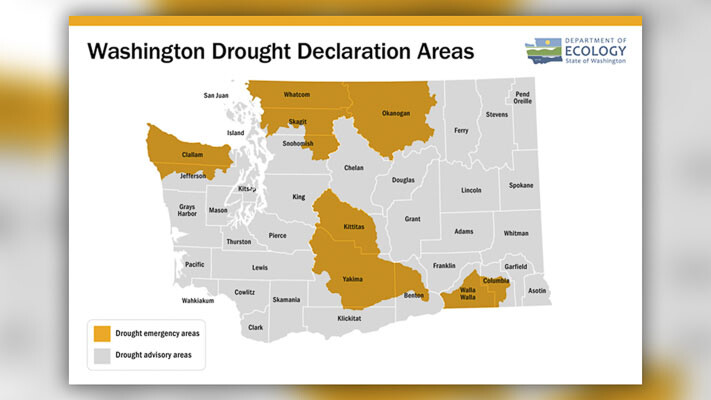
As of July 25, the monthly rolling average for streamflow in vast portions of Washington is below the 10th percentile when compared to those historical averages
Timothy Schumann
The Center Square Washington
In a presentation to the Joint Legislative Committee on Water Supply During Drought, representatives from the Department of Ecology went over what led to the recent drought declaration and what the corresponding $3 million in grant funding means for communities.
“A main one is that we look at water supply seasonal forecasts. What is the volume of runoff expected, especially for that April through September period, which in our state is when water supply challenges are likely to arise?” asked Jeff Marti, Drought Coordinator for the Department of Ecology’s Water Resources Division, during Monday’s committee meeting.
Marti went on to explain that there are 62 watersheds defined within the state, also known as Water Resource Inventory Area or WRIA’s.
The watersheds themselves are not bound by borders, either regional or international. They follow the flow of water and snowmelt, with some passing through state lines and even up into large portions of Canada.
“We declared [a drought] in 12 out of the 62 WRIA’s throughout the state, and they happened to be located in 12 counties,” explained Marti.
He went on to describe the conditions that lead to the drought declaration, noting that as of the beginning of May statewide snowpack was near the 100th percentile of historical norms.
By the end of May, those numbers were looking much worse, with many of the WRIA’s where the drought was declared being below the 50th percentile of historical norms.
“We had really rapid snowmelt this year because May was an extraordinarily warm May,” said Marti, noting the month tied 1958 for the warmest May, based on temperature records going back to 1895.
As of July 25, the monthly rolling average for streamflow in vast portions of Washington is below the 10th percentile when compared to those historical averages. Three watersheds even set historical records for lowest flows ever recorded.
“About 75 percent of our stream gauges are either below normal or worse as of today,” said Marti, signifying a flow rate of 25% or less than historical averages.
These numbers line up with projections from the Office of the Washington State Climatologist, showing stream flow in May well above historical averages, and the surrounding months significantly below average.
The presentation went on to highlight what new laws mean for this drought declaration.
“This year, we were really fortunate,” said Dave Christensen, Deputy Program Manager for the Department of Ecology Water Resources Division before going on to discuss House Bill 1138, signed into law by Gov. Jay Inslee on May 4.
“The bill provided, automatically, funding to Ecology upon the declaration of a drought even if that declaration occurred after the Legislature was out of session,” added Christensen, citing examples from prior years where this was not the case.
The new law went into effect on July 23.
“We have in this year’s biennial budget, $2 million for drought planning, preparedness, and climate resiliency,” he added, noting the Department of Ecology is getting that funding out later this year to prepare for next year’s drought season.
Along with this came an additional $3 million in grant funding available immediately upon declaration of a drought.
These funds are available to a variety of governmental organizations, but will require a 50% match from local sources. Projects must provide benefits and start during the declared drought period, but they do not have to be completed during the drought declaration.
The lone exception to the 50% match are public water systems in disadvantaged communities, which can request a waiver if eligible.
Drought conditions were declared by the Department of Ecology on July 24.
This report was first published by The Center Square Washington.
Also read:
- House Democrats advance $18B in tax hike proposals as session winds downHouse Democrats in Washington advanced several tax hike proposals as the legislative session nears its end, aiming to address a major budget shortfall.
- Republican budget leaders see showdown ahead as Senate Democrats approve trio of major tax increasesSenate Democrats in Washington have approved major tax increases, prompting Republican budget leaders to warn of a growing showdown ahead.
- Representatives from the 18th and 20th Legislative Districts to hold joint town hall on May 3Lawmakers from the 18th and 20th Legislative Districts will host a joint town hall on May 3 at Battle Ground City Hall to review the legislative session and hear from residents.
- Expect delays on northbound I-5 near Ridgefield through May 9Northbound I-5 travelers near Ridgefield should expect delays through May 9 as crews work on improvements at the Exit 14 off-ramp to support future development.
- Brandon Erickson announces candidacy for Clark County Charter Review CommissionBrandon Erickson has announced his candidacy for the Clark County Charter Review Commission, seeking Position 1 in District 2.
- Clark County Sheriff’s Office investigating a reported burglary that led to apparent suicideThe Clark County Sheriff’s Office is investigating a reported burglary in Vancouver that ended with the apparent suicide of Charles Gardiner, interim chief of the Cowlitz Tribal Public Safety Department.
- POLL: Why did voters reject all three tax proposals in the April 22 special election?Clark County voters rejected all three tax measures on the April 22 special election ballot, prompting questions about trust, affordability, and communication.











